
views
Trying Out the Product or Service

Try out the product or service. In order to write a review, you need to try the product. It seems obvious, but many people still write reviews without much first-hand knowledge of the product. Try it out, take your time, and get to know the product or service adequately enough to be able to speak authoritatively about it.

Take notes. Gather details that you’ll need to write your review. For example, if you’re reviewing a restaurant, get the names and ingredients of certain dishes you’re trying. Take note of the décor. Jot down the name of your server.

Take photographs. In some cases, your review will be enhanced by photos. Document your experience by taking pictures so that your readers will know what you mean when you say, “There was a giant stain on the ceiling in my hotel room.”
Organizing Your Review

Find out the parameters for the review. If you are planning to submit your review to a particular website, blog or magazine, make sure you find out any specifications for the review. For example, there might be a word limit or a specific format. Check the deadline too, especially if the review is for something timely, like a movie, album or book. Your review should coincide with the release of these types of items.

Figure out your angle. Every review has a particular perspective. You are, after all, making an argument in your review. Determine how you want to talk about the product or service. Will this be a positive or negative review? What will you focus on? This works especially well for a book or movie review, where you might pick out a particular theme and write your review around that theme.

Know your audience. Think about who will read your review. Are you writing for a heavy metal music blog and your readers will already know various bands and songs? Are you writing a more technical review and your readers will understand jargon that you include? If you are writing for a more general audience, assume that some readers will need more explanation about certain references or terms you use.
Writing Your Review

Briefly describe the product or service. In a couple of sentences or less, describe the product that you’re reviewing. You will reveal other details throughout your review, but the initial description will give your reader a sense of what you’re talking about. If it’s a movie or book, don’t spend your entire review summarizing the plot. There’s no need to give the entire story. Just a brief overview in 1-2 sentences will suffice.

Write with detail. Give lots of detail and evidence for the argument that you’re making. If you’re reviewing a music album, talk about the instruments or vocals on a particular track. If you’re reviewing a movie, talk about why the cinematography is groundbreaking and give examples from the film.
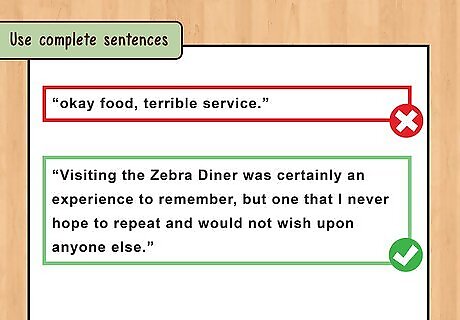
Use complete sentences. Your review will carry much more weight if you write in complete sentences, rather than fragments that leave the reader wanting more. Don’t write things like, “okay food, terrible service.” This doesn’t tell the reader anything specific and therefore doesn’t make for a helpful review.
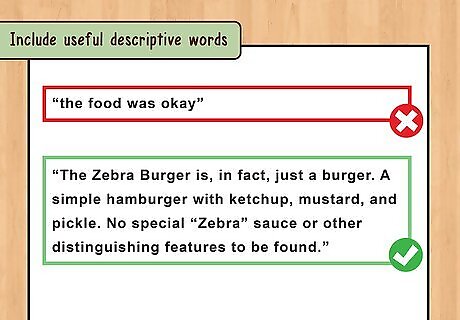
Include useful descriptive words. Skip words like “meh” and “okay.” These words are not very useful in terms of describing a product. If you want to write a compelling review that gives the reader an idea of what you experienced, choose more descriptive words.Also remember that when writing your review it needs to flow and should be consistent.

Personalize your review. Relate your review directly to your personal experience. Don’t use vague statements and generalities. People reading your review will want to know about your experience, so they can determine if they’d like to use that service as well. Tell a story about why you like to go to a particular nightclub or why you find your yard service so reliable.

Position this product or service among its peers. Think about where this product fits among similar products. You should certainly judge the product on its own merits, but people reading your reviews will find it useful to have a reference to a restaurant they’re familiar with. This makes the comparison – and thus, the evaluation of whether to try a product or service – easier for readers of your review.

Include a sample. If possible, give your reader a sample of what you’ve experienced. This might be a picture of a meal that you ate, or it might be a link to a trailer for the movie, or it might be a snippet of a song from an album you’re reviewing.
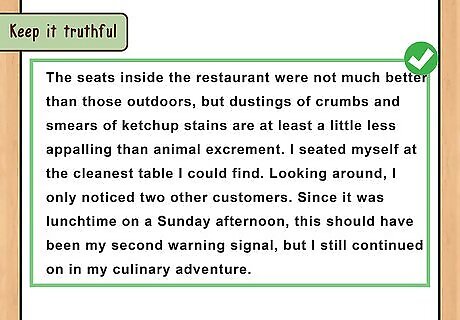
Keep it truthful. Be honest in your review. Don’t stretch the truth to fit with your argument one way or another. Don’t make up stuff or exaggerate to make your point. If you don’t have enough evidence to support a point you’re making, leave it out.

Give a fair review. You may have had a terrible experience with a particular plumber, but balance your review with what the plumber did right. If a meal was excellent except for the crud in your water glass, mention the negative part. People find reviews more credible if they admit the good and the bad together.

Be creative and interesting. The best reviews are ones that hook the reader and draw them in. Write in a way that is imaginative and that captures the essence of the product or service that you’re reviewing. Some reviews are written in different formats, even as poems or haiku. Other reviews are tongue-in-cheek, conveying the facts in a humorous way.
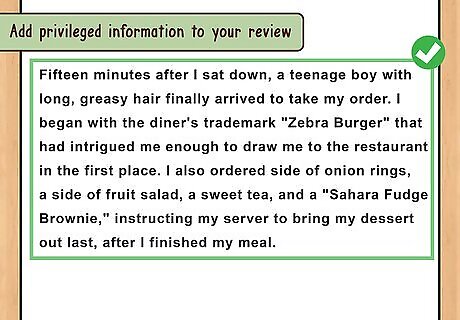
Add privileged information to your review. Include information that a reader wouldn't have from checking out the service’s website or seeing an ad for the service. Provide information or details that you can only get when you’re using the service.
Finalizing Your Review

Make your review clear and concise. Don’t overdo the review with over-the-top praise or criticism. Eliminate extraneous words so that your meaning is clear in the review.
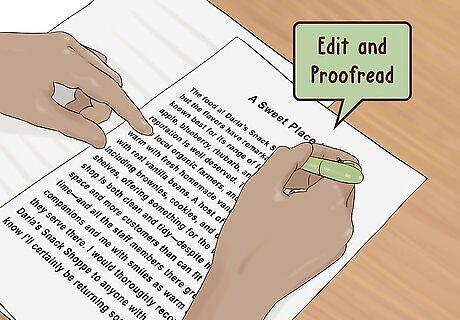
Proofread your review. Take some time to read through your review carefully, checking for proper grammar and spelling. People will discount your review if it’s full of grammatical errors that make it hard to read.

Have someone else read it. Give your review to someone to read before you post it online or publish it. It’s a good rule of thumb to have someone else read your writing to ensure that your writing is clear and your main points are adequately supported.

Submit your review. If you are publishing your review with a magazine, blog or other source, send in your review. Your review may need to go through an editor and may take a bit of time to be printed or posted online. If you’re submitting your review to a website like Yelp or Amazon, follow their review guidelines to ensure that your review will be accepted and posted.



















Comments
0 comment